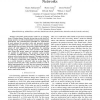Free Online Productivity Tools
i2Speak
i2Symbol
i2OCR
iTex2Img
iWeb2Print
iWeb2Shot
i2Type
iPdf2Split
iPdf2Merge
i2Bopomofo
i2Arabic
i2Style
i2Image
i2PDF
iLatex2Rtf
Sci2ools
INFOCOM
2007
IEEE
2007
IEEE
End-to-End Routing for Dual-Radio Sensor Networks
— Dual-radio, dual-processor nodes are an emerging class of Wireless Sensor Network devices that provide both lowenergy operation as well as substantially increased computational performance and communication bandwidth for applications. In such systems, the secondary radio and processor operates with sufficiently low power that it may remain always vigilant, while the the main processor and primary, high-bandwidth radio remain off until triggered by the application. By exploiting the high energy efficiency of the main processor and primary radio along with proper usage, net operating energy benefits are enabled for applications. The secondary radio provides a constantly available multi-hop network, while paths in the primary network exist only when required. This paper describes a topology control mechanism for establishing an end-to-end path in a network of dual-radio nodes using the secondary radios as a control channel to selectively wake up nodes along the required end-to-end ...
| Added | 03 Jun 2010 |
| Updated | 03 Jun 2010 |
| Type | Conference |
| Year | 2007 |
| Where | INFOCOM |
| Authors | Thanos Stathopoulos, Martin Lukac, Dustin McIntire, John S. Heidemann, Deborah Estrin, William J. Kaiser |
Comments (0)

